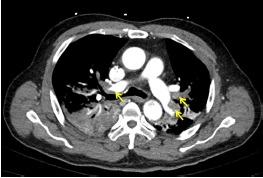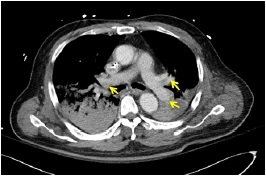Kosin Med J.
2018 Dec;33(3):477-482. 10.7180/kmj.2018.33.3.477.
A case of rescuing a patient with acute cardiovascular instability from sudden and massive intraoperative pulmonary thromboembolism by extracorporeal membrane oxygenation
- Affiliations
-
- 1Department of Anesthesiology & pain medicine, Dongtan sacred heart hospital, Hwaseong, Korea. wj131@hallym.or.kr
- KMID: 2442562
- DOI: http://doi.org/10.7180/kmj.2018.33.3.477
Abstract
- Intraoperative pulmonary thromboembolism is a high mortality situation. Early mortality in patients with pulmonary thromboembolism varies from 2% in normotensive patients to 30% in patients with cardiogenic shock. The use of extracorporeal cardiopulmonary resuscitation can improve survival and neurologic outcomes of cardiac arrest. We report a case of intraoperative massive pulmonary thromboembolism with circulatory collapse and cardiac arrest during anesthesia for pelvic bone fracture surgery, which were rescued by extracorporeal membrane oxygenation.
MeSH Terms
Figure
Cited by 1 articles
-
Fat embolism syndrome: a review in cosmetic surgery
Hongil Kim, Bommie Florence Seo, Gregory Randolph Dean Evans
Kosin Med J. 2024;39(3):169-178. doi: 10.7180/kmj.24.126.
Reference
-
1. Chen YS, Lin JW, Yu HY, Ko WJ, Jerng JS, Chang WT, et al. Cardiopulmonary resuscitation with assisted extracorporeal life-support versus conventional cardiopulmonary resuscitation in adults with in-hospital cardiac arrest. an observational study and propensity analysis. Lancet. 2008; 372:554–561.
Article2. Geerts WH, Bergqvist D, Pineo GF, et al. American College of Chest Physicians. Prevention of venous thromboembolism. American College of Chest Physicians Evidence-Based Clinical Practice Guidelines (8th Edition). Chest. 2008; 133:6 Suppl. 381S–453S.3. Chana-Rodríguez F, Mañanes RP, Rojo-Manaute J, Haro JA, Vaquero-Martín J. Methods and Guidelines for Venous Thromboembolism Prevention in Polytrauma Patients with Pelvic and Acetabular Fractures. Open Orthop J. 2015; 9:313–320.
Article4. Conrad SA, Rycus PT. Extracorporeal membrane oxygenation for refractory cardiac arrest. Ann Card Anaesth. 2017; 20:S4–S10.
Article5. ELSO guidelines. Extracorporeal life support organization, version 1.3. ANN Arbor: USA;2013. 11. available at: https://www.elso.org/resources/guidelines.aspx.6. Debaty G, Babaz V, Durand M, Gaide-Chevronnay L, Fournel E, Blancher M, et al. Prognostic factors for extracorporeal cardiopulmonary resuscitation recipients following out-of-hospital refractory cardiac arrest. A systematic review and meta-analysis. Resuscitation. 2017; 112:1–10.
Article
- Full Text Links
- Actions
-
Cited
- CITED
-
- Close
- Share
- Similar articles
-
- Life-Threatening Acute on Chronic Pulmonary Thromboembolism Requiring Extracorporeal Membrane Oxygenation
- Thrombolytic Therapy Complemented by ECMO: Successful Treatment for A Case of Massive Pulmonary Thromboembolism with Hemodynamic Collapse
- Massive Pulmonary Thromboembolism Treated with Heparin and Extracorporeal Membrane Oxygenation During Cardiogenic Shock
- Massive Endobronchial Hemorrhage After Pulmonary Thromboendarterectomy in Chronic Pulmonary Embolism
- Successful Extracorporeal Membrane Oxygenation Support for Acute Pulmonary Thromboembolism during Adult Liver Transplantation




